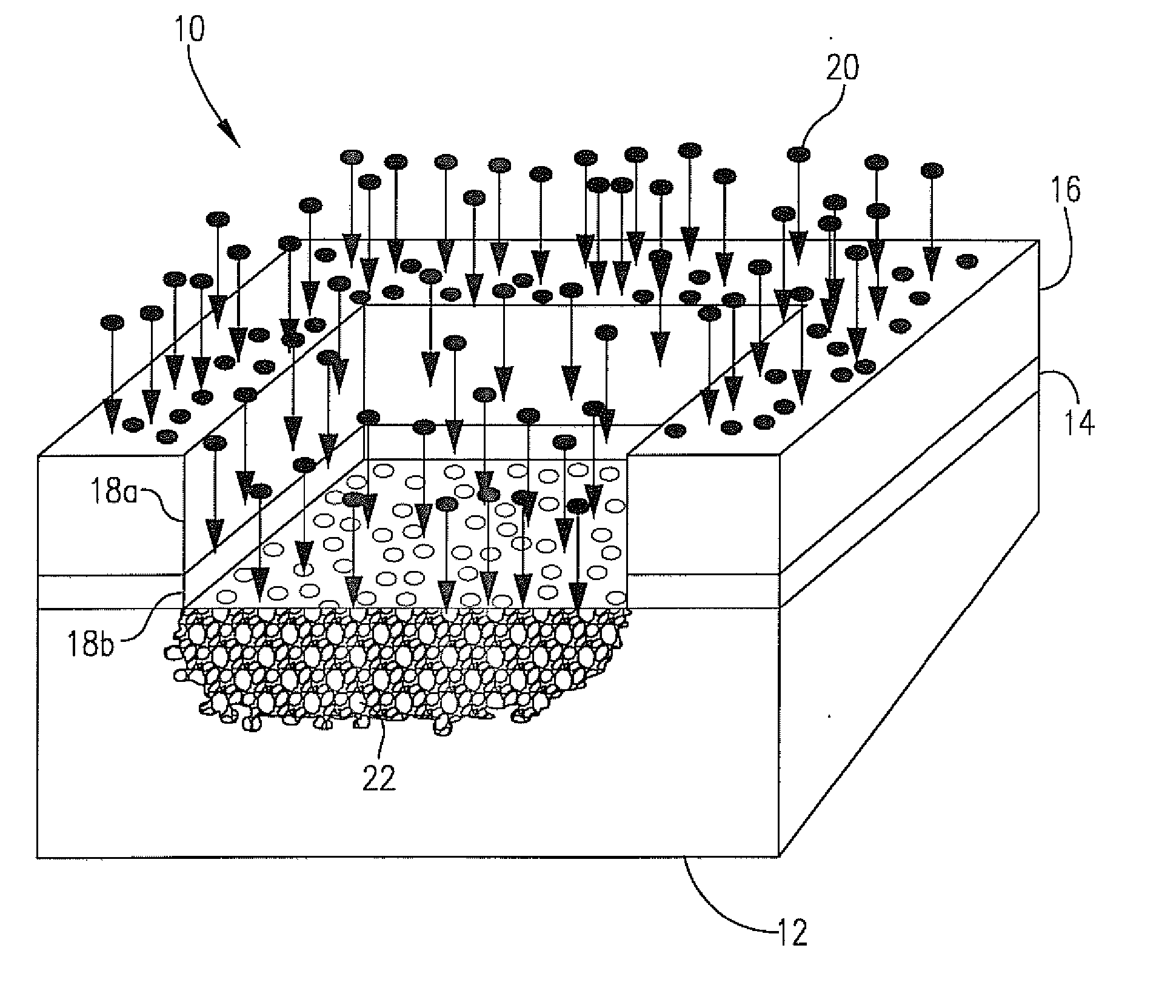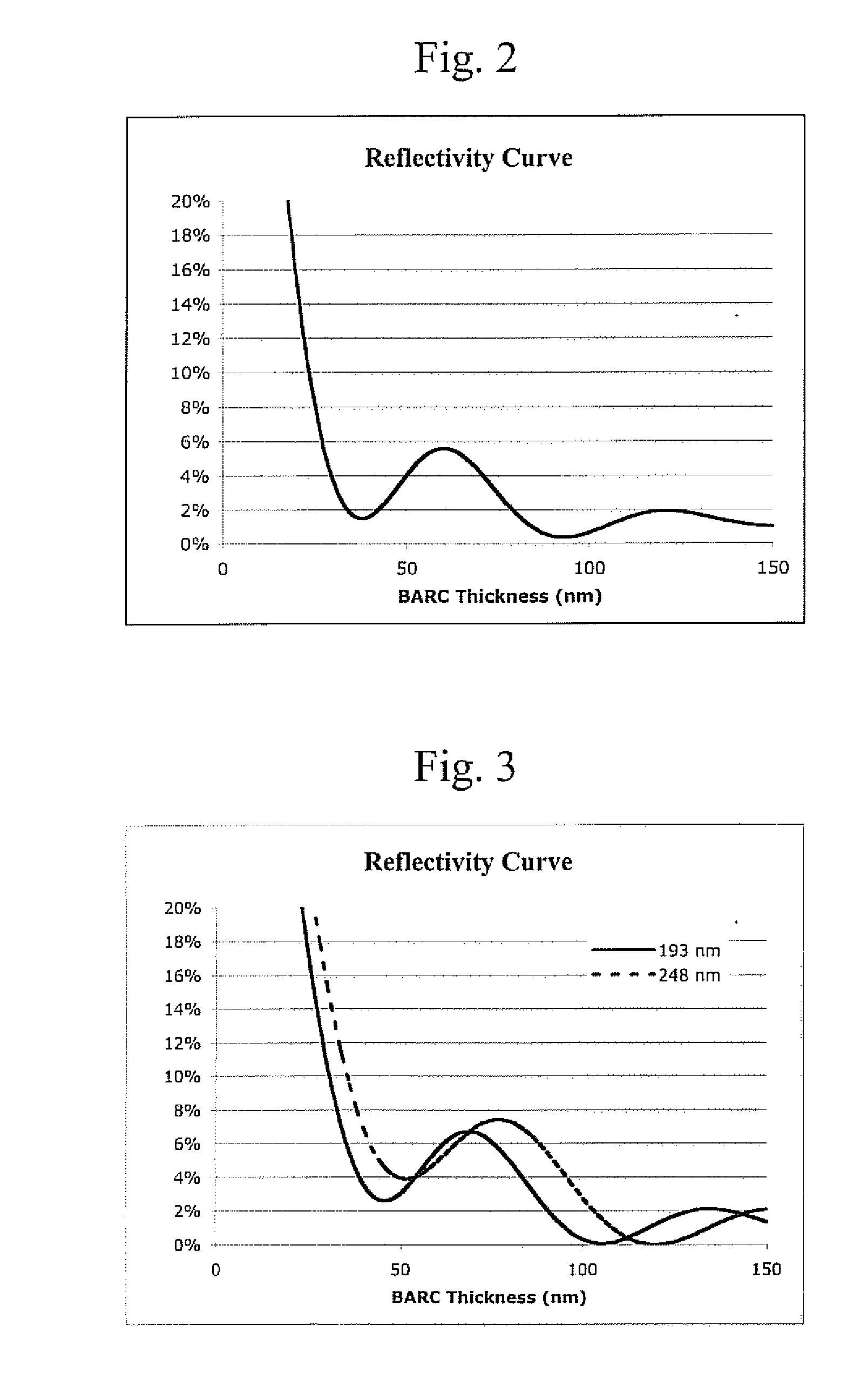Anti-reflective coatings using vinyl ether crosslinkers
a technology of anti-reflective coating and crosslinker, which is applied in the direction of photosensitive materials, instruments, photomechanical equipment, etc., can solve the problems of resist loss, resist line undercutting, and resist thickness loss during the bottom anti-reflective coating and substrate etch steps becomes critical, and achieves high solubility. the effect of high resistance, shortening the manufacturing process and less cos
- Summary
- Abstract
- Description
- Claims
- Application Information
AI Technical Summary
Benefits of technology
Problems solved by technology
Method used
Image
Examples
example 1
Polymer Composition Without Acid Sensitive Groups
[0054] A homopolymer of methacryloyloxy ethyl phthalate (28.9 mmol, obtained from Aldrich) and 2,2′-azobisisobutyronitrile (“AIBN,” 0.58 mmol radical initiator, obtained from Aldrich) were mixed in 50 ml THF (obtained from Aldrich) under a nitrogen atmosphere and heated to reflux for 15 hours. The reaction was allowed to cool, concentrated to about 25 ml, and then precipitated into 200 ml hexane. After filtration and drying, about 8 grams of the remaining white powder were collected. The polymer molecular weight (“Mw”) was measured by using polystyrene standards and gel permeation chromatography (“GPC”) and was determined to be 68,400.
[0055] A 193-nm bottom anti-reflective coating was prepared as follows: A 3% solids formulation containing ethyl lactate (“EL,” obtained from General Chemical), the polymer prepared above, 28% by weight Vectomer 5015 (a vinyl ether crosslinker obtained from Aldrich), and 4% by weight triphenyl sulfoniu...
example 2
Bottom Anti-Reflective Coating Containing Chromophore, Acid, and Dissolution Enhancer
[0057] Methacrylic acid (“MAA,” 31.2 mmol, obtained from Aldrich), tert-butyl methacrylate (“tBMA,” 26.0 mmol, obtained from Aldrich), 9-anthracene methyl methacrylate (“9-AMMA,” 14.5 mmol, obtained from St-Jean Photochemicals Inc.), and AIBN (1.4 mmol) were mixed in 60 ml THF under nitrogen atmosphere and heated to reflux for 19 hours. The reaction was allowed to cool, was concentrated to about 35 ml, and was then precipitated into 150 ml hexane. After filtration and drying, about 10 grams of a light yellow powder were collected. The polymer Mw, measured by using polystyrene standards and GPC, was determined to be 23,800.
[0058] A 3% solids formulation containing the polymer, PGME (obtained from General Chemical), PGMEA (obtained from General Chemical), 10% tetrafunctional vinyl ether cross linker prepared in-house as described above, and 4% triphenyl sulfonium triflate (a PAG obtained from Aldric...
example 3
Control of Optical Properties by Polymer Composition
[0059] Several polymers were prepared using the procedure in Example 2 and using varying amounts of chromophore (9-AMMA) in order to demonstrate control of the optical properties of the bottom anti-reflective coating while maintaining dissolution properties. A 3% solids formulation containing PGME, PGMEA, 10% tetrafunctional vinyl ether crosslinker prepared in-house as described above, and 4% triphenyl sulfonium triflate PAG was prepared and filtered through a 0.1-micron endpoint filter.
[0060] Table 2 shows that by increasing chromophore loading in the polymer, optical density, and substrate reflectivity can be controlled.
TABLE 2Reflectivity at 1st9-AMMAn1st MinimumMinimum(Mole %)ak valuevalueOD / μmThickness (Å)Thickness (%)100.271.526.16602.6200.421.45910.86600.08300.541.46213.36200.87
abased upon total moles of solids in composition
PUM
| Property | Measurement | Unit |
|---|---|---|
| feature sizes | aaaaa | aaaaa |
| temperature | aaaaa | aaaaa |
| sizes | aaaaa | aaaaa |
Abstract
Description
Claims
Application Information
 Login to View More
Login to View More - R&D
- Intellectual Property
- Life Sciences
- Materials
- Tech Scout
- Unparalleled Data Quality
- Higher Quality Content
- 60% Fewer Hallucinations
Browse by: Latest US Patents, China's latest patents, Technical Efficacy Thesaurus, Application Domain, Technology Topic, Popular Technical Reports.
© 2025 PatSnap. All rights reserved.Legal|Privacy policy|Modern Slavery Act Transparency Statement|Sitemap|About US| Contact US: help@patsnap.com



